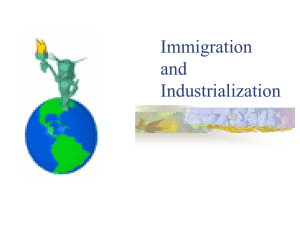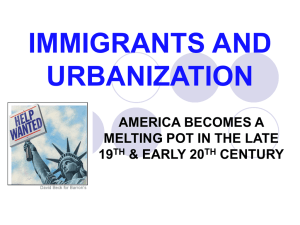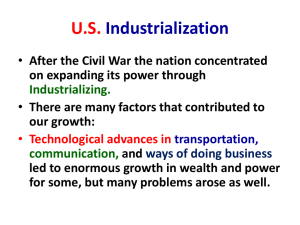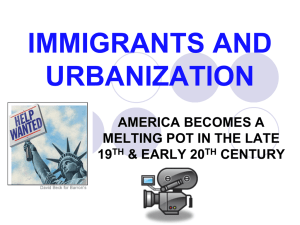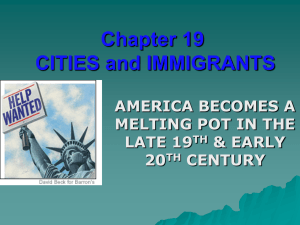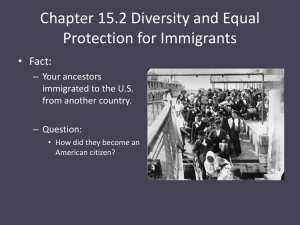Immigrants and Urbanization
advertisement
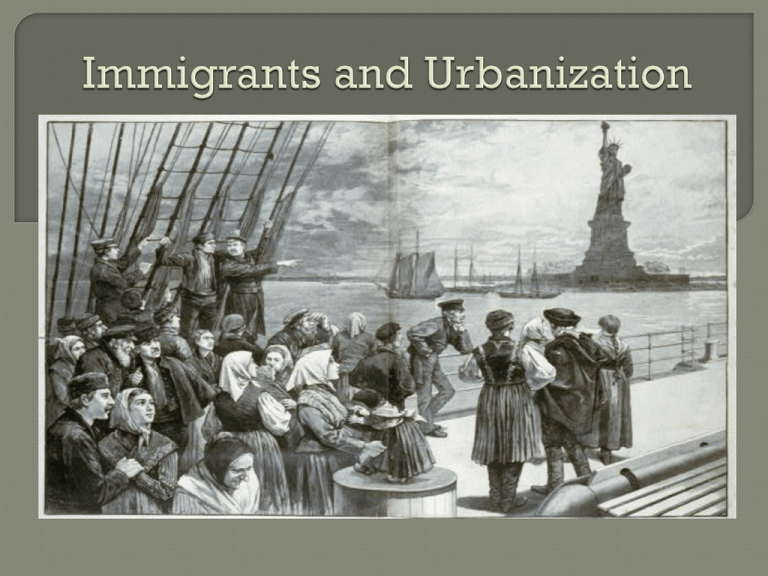
Was given to the U.S. by France to celebrate their 100 years of American Independence from Great Britain. President Grover Cleveland officially dedicated it on October 28, 1886. Main Idea Immigration from Europe, Asia, the Caribbean, and Mexico reached a new high in the late 19th and early 20th centuries. Why it Matters Now This wave of immigration helped make the United States the diverse society it is today. From which parts of the world did immigrants come to the U.S? • Europe-Italy, Hungary, & Russia;Japan and China; Jamaica, Cuba, Puerto Rico. Mexico. For what reason did they journey to America? • Religious persecution, rising populations, jobs, some searched for gold. • “Birds of Passage”-temporary stay, then return home Golden Door Europeans 1870-1920 20 million Chinese/Japanese 1851-1884 300,000/200,000 West Indies/Mexico 1880-1920 260,000/700,000 Southern/Western Europe Religious persecution Rising population jobs Hawaii opened door for Japanese Settled on the West Coast Chinese-Search for Gold Worked on railroads Settled in the Southwest jobs What difficulties did immigrants face on their journey to the United States? • Immigrants crowded together in steerage on ships. They were unable to exercise or catch a breath of fresh air. Disease would spread quickly and many immigrants died before they reached their destinations. Angel Island Difficult Journey Ellis Island ELLIS ISLAND, NEW YORK HARBOR ANGEL ISLAND WAS CONSIDERED MORE HARSH THAN ELLIS ISLAND How did the Chinese Exclusion Act and the Gentlemen’s Agreement limit Asian immigration? • The Chinese Exclusion Act banned entry to all Chinese except students, teachers, merchants, tourists, and government officials. In the Gentlemen’s Agreement, Japan’s government agreed to limit immigration of unskilled workers to the U.S., in exchange for the repeal of the San Francisco segregation order. While some immigrants tried to assimilate into American culture, others kept to themselves and created ethnic communities Committed to their own culture, but also trying hard to become Americans, many came to think of themselves as ItalianAmericans, Polish-Americans, Chinese-Americans, etc Some native born Americans disliked the immigrants unfamiliar customs and languages – friction soon developed Chinatowns are found in many major cities Nativism Restrictions Gentlemen’s Agreement Chinese Exclusion Act Nativism • Prescott Hall-Immigration Restriction League German, Scandanavian, and British 1896- Immigration Restriction League • Required literacy tests • Pres. Cleveland vetoed the bill Anti-Asian • Denis Kearney-Workingmen’s Party In 2000 the U.S. population was 71% Caucasian, 12% African American, 12% Hispanic, 4% Asian, and around 1% Native American. By 2050- 53% Caucasian, 13% African American, 9% Asian, and 1% Native Americans. The greatest increase is expected for Hispanics, who will account for almost 25% of the U.S. Causes 1. 2. 3. 1. 2. 3. 1. 2. 3. Effects Immigrants leave Their home countries Immigrants face hardships in the U.S. Some nativists Want to restrict immigration Study the photograph for 2 minutes. Form an overall impression of the photograph and then examine individual items. Next, divide the photo into quadrants and study each section to see what new details become visible. People Objects Activities Based on what you have observed above, list three things you might infer from this photograph. • 1. • 2. • 3. What questions does this photograph raise in your mind? Which group of immigrants do you think faced the greatest challenges in the United States? Why? Homework: Due Tuesday • Find stories of immigration or the experiences of recent immigrants to U.S. that you have heard or read about. Create a presentation of these stories. Use pictures, text, or sound to represent the stories. Main Idea The rapid growth of cities forced people to contend with problems of housing transportation, water, and sanitation Why it Matters Now Consequently, residents of U.S. cities today enjoy vastly improved living conditions Why did many immigrants settle in the nation’s cities? • Cities were cheaper and cities offered jobs. Opportunities Settle in Cities Migration to the City Americanization movement Ethnic Communities Better Machinery African Americans move North What were the housing problems that many poor city dwellers faced? • Housing was overcrowded and cramp. Sanitation and plumbing were problems. <> Housing Tenements Row houses Fire Volunteers Cincinnati, OH1st Transportation Mass transit Urban Problems Crime 1844police Water Filtration Chlorine Sanitation Scavengers 1900-sewer lines Jacob Riis Jacob Riis Jacob Riis Jacob Riis Jacob Riis Jacob Riis Settlement House Movement • Social Gospel Movement- salvation through service of the poor • Settlement houses-community centers in poor areas. • Ran by college educated women. • Jane Addams and Ellen Star Gates Hull House (1889)- Chicago • Jamie Porter Barrett Locust St. Social Settlement (1890)-Hampton, VA • 1910- more than 400 settlement houses. Describe the movement of immigrants to cities and the opportunities they found there. Explain how cities dealt with housing, transportation, sanitation, and safety issues. Describe some of the organizations and people who offered help to urban immigrants. Main Idea Local and national political corruption in the 19th century led to calls for reform. Why it Matters Now Political reforms paved the way for a more honest and efficient government in the 20th century and beyond. Why did machine politics become common in big cities in the late 19th century? • The growing need for city services and the large number of immigrants required a new power structure. City Bosses Ward Bosses Precinct Workers and Captains What means did many political machines use to maintain power? • Political machines took “kickbacks” or illegal payments for their services, enriched the political machines. They also granted favors to businesses in return for cash and accepted bribes to allow illegal activities. Gilded Age Politics Political Machines Immigrants & The Machine Controlled Activities Boss’ helped immigrants w/naturalization, housing, Jobs, etc. Election Fraud Vote numerous times Kickbacks Illegal payments for services Bribery Offering $ or service for illegal activity Graft Patronage Illegal use of political influence for political gain “Spoils System”- giving gov’t jobs to help get a candidate elected; Stalwarts;Pendleton Civil Service Act The Tweed Ring Scandal • William Tweed “Boss Tweed” Head of Tammany Hall Defrauded the city • New York County Courthouse $13 Million, actual cost $3 million • Thomas Nast Exposed Tweed for wrong doing. Political cartoons What government problems arose as a result of patronage? • Inefficiency, fraud, and imcompetence Nast depicts the Tweed Ring: "Who stole the pople's money?" / "'Twas him." Nast shows Tweed's source of power: control of the ballot box. "As long as I count the Votes, what are you going to do about it Reform Rutherford B. Hayes James A. Garfield Chester A. Arthur Investigated Nation’s Customhouses Gave Reformers Jobs Assassinated Charles Guiteau July 2, 1881 Pendleton Civil Service Act 1883 Harrison, Cleveland, and High Tariffs • Big business hoped for protection • Democratic party opposed high tariffs. Tariffs Grover Cleveland Benjamin Harrison Tried to Lower tariffs McKinley Tariff Act 1890 Summarize the views of Grover Cleveland and Benjamin Harrison on tariffs. • Cleveland wanted to reduce tariffs; Harrison wanted to keep them high. Election Fraud Patronage Kickbacks Corruption Graft Bribery Test Today!! Unit I Exam: The Gilded Age and the West Place all notes and worksheets in the following order: • Ch.10 Vocabulary • Ch.10 Section 1-Immigration/Ch.10 Section 2- Urbanization • Worksheet- Immigration Facts • Worksheet-Industry and Urban Growth • Ch.10 Section 3- Politics of the Gilded Age/Political Cartoon Following the test, pick up the Building Vocabulary for Progressive Era

